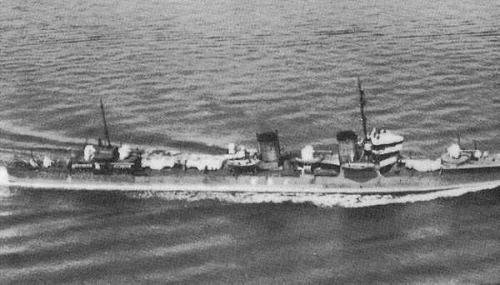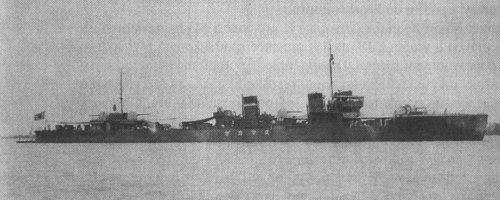
NAVYPEDIA
 Support the project with paypal
Support the project with paypal
Photo

Nokaze 1939
Ships
| Name | No | Yard No | Builder | Laid down | Launched | Comp | Fate |
|---|---|---|---|---|---|---|---|
| 峯風 [Minekaze] | Maizuru K K | 4.1918 | 8.2.1919 | 5/1920 | stricken 1938, commissioned again 1940, sunk 10.2.1944 | ||
| 沢風 [Sawakaze] | 289 | Mitsubishi, Nagasaki | 1.1918 | 7.1.1919 | 3.1920 | surrendered 8.1945, BU 1948 | |
| 沖風 [Okikaze] | Maizuru K K | 2.1919 | 3.10.1919 | 8.1920 | stricken 1938, commissioned again 1940, sunk 10.1.1943 | ||
| 矢風 [Yakaze] | 301 | Mitsubishi, Nagasaki | 8.1918 | 10.4.1920 | 7.1920 | target 7.1942, patrol escort 1.1945, surrendered 8.1945, BU 1948 | |
| 羽風 [Hakaze] | 302 | Mitsubishi, Nagasaki | 11.1918 | 21.6.1920 | 9.1920 | sunk 23.1.1943 | |
| 灘風 [Nadakaze], 1939- 第2号哨戒艇 [2-go] | Maizuru K K | 1/1920 | 26.6.1920 | 9.1921 | patrol escort 1939, sunk 25.7.1945 | ||
| 島風 [Shimakaze], 1939- 第1号哨戒艇 [1-go] | Maizuru K K | 9/1919 | 31.3.1920 | 11.1920 | patrol escort 1939, sunk 21.1.1943 | ||
| 秋風 [Akikaze] | 335 | Mitsubishi, Nagasaki | 6.1920 | 14.12.1920 | 4.1921 | sunk 3.11.1944 | |
| 汐風 [Shiokaze] | Maizuru K K | 5.1920 | 22.10.1920 | 7.1921 | damaged 31.1.1945, never repaired | ||
| 夕風 [Yukaze] | 336 | Mitsubishi, Nagasaki | 12.1920 | 28.4.1921 | 8.1921 | damaged 18.7.1945, never repaired | |
| 帆風 [Hokaze] | Maizuru K K | 11.1920 | 12.7.1921 | 12.1921 | sunk 6.7.1944 | ||
| 太刀風 [Tachikaze] | Maizuru K K | 8.1920 | 31.3.1921 | 12.1921 | sunk 17.2.1944 | ||
| 野風 [Nokaze] | Maizuru K K | 4.1921 | 1.10.1921 | 3.1922 | sunk 20.2.1945 | ||
| 波風 [Namikaze] | Maizuru K K | 11.1921 | 24.6.1922 | 11.1922 | surrendered 8.1945, to China 10.1947 (瀋陽 [Shen Yang]) | ||
| 沼風 [Numakaze] | Maizuru K K | 8.1921 | 25.2.1922 | 7.1922 | sunk 19.12.1943 |
Technical data
| Displacement normal, t | 1345 |
|---|---|
| Displacement full, t | 1650 |
| Length, m | 97.5 pp 102.6 oa |
| Breadth, m | 9.00 |
| Draught, m | 2.90 |
| No of shafts | 2 |
| Machinery | 2 sets Parsons geared steam turbines, 4 Kampon boilers |
| Power, h. p. | 38500 |
| Max speed, kts | 39 |
| Fuel, t | oil 395 - 400 |
| Endurance, nm(kts) | 3600(14) |
| Armament | 4 x 1 - 120/45 3-shiki, 2 x 1 - 7.7/80, 3 x 2 - 533 TT, 20 mines |
| Complement | 148 |
Standard scale images

Minekaze 1920

Namikaze 1944

Namikaze 1941

2-go 1941
Graphics
Project history
Minekaze class destroyers (oceangoing 1st class destroyers under Japanese classification ) became first IJN ships, built in rather a large batch. In total in limits of "8-4" Programme IJN received 15 ships of this class.
In designs of previous destroyer classes of the IJN effect of foreign schools of shipbuilding (first of all British) was obviously traced. In Minekaze class the tendency to withdrawal from this practice was scheduled. The unusual outline profile generated by new arrangement of No1 TT, became their original feature, as well as all the subsequent Japanese destroyers built in early 1920th. On predecessors (Amatsukaze and Kawakaze classes), served by a starting point at designing of Minekaze, this TT was positioned behind forecastle break before the first funnel. In new design the bridge has been notably moved astern (that theoretically made it "drier"), and TT was transferred forward, having appeared cramped between short forecastle and a bridge-house. Similar decision already met earlier on German torpedo boats. At a number of advantages laying on a surface (expansion of fire angles and damage tolerance raise) such arrangement conducted to seaworthiness decrease, even in conditions concerning the North Sea. Having considered accumulated negative experience, Germans in later designs of torpedo boats have refused this scheme. As design of Minekaze has been completed even before the First World War end, Japanese designers could not take advantage of the accumulated German Navy operating experience of torpedo boats with bow placing TT (detailed acquaintance became possible only in 1920 when IJN has had an opportunity to study German ships which have got on a reparation). At all similarity arrangement of TT on Japanese destroyers had a number of basic differences from the German ones. So, rake of forecastle frames on the former was much more, that, on the one hand, stored seaworthiness at comprehensible level, but with another brought to nothing all advantages of bow placing of TT, as its turn angles were notably narrowed (besides, instead of standing on German ships single side-mounted TT, Japanese have twin TT in centreline).
Minekaze class ships became first large serial-built Japanese destroyers equipped with geared turbines. Similar machinery was tested on destroyers of previous Kawakaze class. In comparison with a prototype, engine power of Minekaze has been a little raised (from 37000 to 38500hp), that has allowed to decrease max speed to 39kts, and smoke duct of boilers were deduced not in three, and in two funnels. The armament structure also basically repeated accepted on Kawakaze (3x1 120mm/45 guns and 3х2 533mm TT), differing only by presence of fourth additional 120mm gun. All artillery placed on centreline at one level, and guns No2 and 3 amidships had limited training angles. At three ships of the 1920 program (Nokaze, Namikaze and Numakaze) artillery arrangement was other: gun No3 was transferred from a position behind second funnel to aft superstructure, that though did not increase training angle, but simplified ammunition feeding.
To the mid-1930th ships of this class were considered as become outdated (first of all, because of torpedo armament weakness), and part from them have converted to the auxiliary. In 1937 Yakaze became command and control ship for target ship Settsu. Structure of her armament have significantly shrunk, and freed place was held by wireless control equipment. Okikaze in 1938 was disarmed and stricken. After joining into the war in 1941 she received former armament and was put into operation. Yakaze in September, 1942 was converted to target ship for naval aircraft pilots. Boilers number has been moderated to two (engine power was shrank to 11260hp, max speed to 24kts), instead of old funnels there were two new with smaller diameter. Superstructures, funnels and bridge have received light armour protection, armament was shrank to 1 light 47mm gun and four 25mm MGs. In the end of war Yakaze again was converted to escort.
Namikaze during repair of battle damages (undermining in September, 1944) has been converted to carrier of human torpedoes Kaiten. Her stern have extended and have made raking, on centreline the rails for two human torpedoes placed. One boiler from fore boiler room was removed, then max speed has decreased to 28kts. Shiokaze, damaged in January, 1945, planed to convert similarly, but with placing already of four human torpedoes, however till the end of war works have not been completed. Sawakaze in 1945 was converted to anti-aircraft patrol. Thus she has lost last TT, and on a place before removed No3 gun as experiment received 9-barrel launcher of 150mm anti-submarine rockets.
Modernizations
1937, Yakaze: was converted to control ship of target Settsu: - 2 x 1 - 120/45, 3 x 2 - 533 TT, 20 mines
1937 - 1938, Minekaze, Okikaze, Hakaze, Nadakaze, Shimakaze, Akikaze, Shiokaze, Yukaze, Hokaze, Tachikaze, Nokaze, Namikaze, Numakaze: were modified, solid ballast was added, standard displacement increased to 1552t, maximal speed fell to 36kts, fuel stowage was 275t on Minokaze and Okikaze, 230t on Shimakaze, Akikaze, Shiokaze, Yukaze, Nadakaze and 295t on Hakaze, Hokaze and Tachikaze.
1939 - 1940, Kamikaze, Nokaze, Numakaze, Namikaze: were modified, solid ballast was added, standard displacement rose 1652t, maximal speed was 34.5kts. (Kamikaze had 1784t and 34kts)
1939, 1, 2-go: were converted to patrol escorts; 2 boilers were removed, engine power was 19250hp and maximal speed 22kts, fuel stowage was about 300t, displacement was 1390 / 1700t; - 2 x 1 - 120/45, 2 x 1 - 7.7/80, 2 x 2 - 533 TT, mines; + 5 x 2 - 25/60 96-shiki, 2 DCT (16), 93-shiki sonar
1941, 1, 2-go: were converted to fast attack transports; - 1 x 1 - 120/45; + 2 14m Daihatsu landing craft, accommodation for 250 marines
7.1942, Yakaze: was converted to target; 2 boilers were removed, engine power was 11260hp, maximal speed was 24kts, armament consisted of 1 x 1 - 76/40 3-shiki, 2 x 2 - 25/60 96-shiki
1942 - 1943, all survived destroyers: - 2 x 1 - 120/45, 2 x 1 - 7.7/80, 2 x 2 - 533 TT; + 5 x 2 - 25/60 96-shiki, 4 DCT, 2 DCR (36), 93-shiki sonar
late 1944, all survived destroyers: + (6 - 10) x 1 - 25/60 96-shiki
autumn 1944, Namikaze: 1 boiler was removed, stern was lengthened, maximal speed fell to 28kts. - 1 x 1 - 120/45, 1 x 2 - 533 TT; + 8 x 1 - 13.2/76, 2 Kaiten human torpedoes (she had 20 25/60 guns at all), 2-shiki 2-go radar
194, Shiokaze, Yukaze: + 3-shiki 1-go radar
1.1945, Yakaze: converted to patrol escort; armed with 2 x 1 - 120/45 3-shiki, 5 x 2 - 25/60 96-shiki, 2 x 1 - 25/60 96-shiki, 1 x 2 - 533 TT, 4 DCT (36), 93-shiki sonar
4.1945, Sawakaze: - 1 x 1 - 120/45, 1 x 2 - 533 TT; + 1 x 9 - 150 ASWRL, 2-shiki 2-go radar
Naval service
Okikaze 10.1.1943 was sunk SE off Yokosuka by American submarine Trigger. P1 (ex-Shimakaze) was sunk at Kavieng 13.1.1943 by American submarine Guardfish. Hakaze 23.1.1943 was sunk in 15nm SW off Kavieng by American submarine Guardfish. Minekaze 10.2.1944 was sunk by American submarine Pogy off Formosa. Hokaze 1.7.1943 was damaged by torpedo from American submarine Thresher and was under repair till the end of year, 6.7.1944 off Celebes she was sunk by American submarine Paddle. Numakaze 19.12.1943 was sunk NE off Okinawa by American submarine Grayback. Tachikaze 27.12.1942 and 6.1.1943 was hard damaged at Rabaul by American aircraft and was under repair till March, 1943, 17.2.1944 she was sunk at Truk by American carrier aircraft (TF.38). Akikaze 3.11.1944 was sunk in 60nm W off Luzon by American submarine Pintado. Nokaze 20.2.1945 was sunk by American Pargo off Cape Varella. Р2 (ex-Nadakaze) 25.7.1945 was sunk E off Surabaya by British submarine Stubborn. Namikaze 8.9.1944 was hard damaged on a mine laid by American submarine Seal, in October, 1947 she was transferred on a reparation to China. Shiokaze 31.1.1945 was hard damaged by American aircraft; till the end of war repair s not completed; she was handed over on demolition in 1948. Yakaze 10.3.1942 was damaged by American carrier aircraft, repaired and converted to target ship till May, 1942; 18.7.1945 at Yokosuka she was damaged by American carrier aircraft, never repaired and broken up in 1947.
 HOME
HOME FIGHTING SHIPS OF THE WORLD
FIGHTING SHIPS OF THE WORLD JAPAN
JAPAN TORPEDO SHIPS
TORPEDO SHIPS MINEKAZE destroyers (1920 - 1922)
MINEKAZE destroyers (1920 - 1922)

